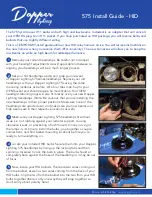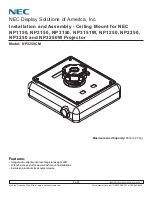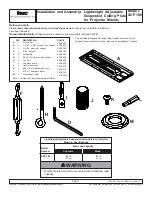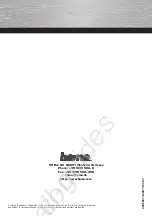
Page 3
MOUNTING FOOT
TINNERMAN
NUT
FOOT
ANCHOR
PLATE
SET
SCREW
Plate slides into
lightbar extrusion
5" Mounting Foot
NUT
BOLT
SPLIT LOCK
WASHER
METAL SCREW
NOTE:
The mounting straps are made to fit the contours of individual
vehicles. The strap
may look different. If your lightbar has a 5"
mounting foot, it will assemble differently than the standard
mounting foot. It also uses an extension to compensate for
the extra height. Follow these illustrations for assembly.
Mounting to the lightbar is the same.
shown here is for example only. The strap
for your vehicle
NOTE:
NOTE:
NOTE:
NOTE:
NOTE:
NOTE:
STRAP
S H E E T
M E T A L
SCREWS
EXTENSION
VEHICLE ROOF
Locking
Plate
Mounting
Foot
Nut
Mounting
Pad
Adjustment
screws
Lock
Washer
Anchor
Plate
Tinnerman
Nut
Tinnerman
Nut
Anchor
Plate
Locking
Plate
Mounting
Strap
Mounting
Screw
Adjustable Mounting Foot / Model MKAJ
Standard Mounting Foot / Model MKEZ
Tighten
screws
with
torque
wrench
set
at
35
to
40
in/lbs
Mounting
Strap
Mounting
Screw
Tension
Bolt
Tension
Bolt
Model
MKAJ
Mounting
Foot
NOTE:
Unless otherwise specified, the
lightbar mounting feet must be sitting as
close to the edge of the roof as possible.
Mounting feet must also be in full contact
with the roof and not be hanging off
the edge.
IMPORTANT:
For strap mounted bars, be sure you have the right
sized lightbar for your vehicle. The lightbar should be about the same
width as the vehicle roof. If the lightbar is too large or small it will not mount properly to the vehicle and may shift or come loose during driving.
1/2" Minimum Clearance at Closest Point
Routing your Lightbar Cable(s)
1.
To protect the headliner from damage caused by drilling the cable access hole
through the vehicle roof, allow a 5” to 7” distance between roof and headliner
by lowering the headliner before drilling.
2.
Using a 1” hole saw, drill the cable access hole.
NOTE: There may
be a roof support
member
that
spans
the
distance between
the driver’s and
passenger’s side.
DO NOT DRILL
THROUGH
THIS
MEMBER! Adjust
the location until the hole can be drilled without hitting the support member.
3.
Use a round file to smooth and de-burr the edges of the hole.
4.
Insert a 1” grommet (user supplied) into the cable access hole.
5.
Insert the cable(s) through the cable access hole into the vehicle. Use RTV
silicone to weatherproof the access hole after the cable(s) are pulled
completely into the vehicle.
6.
Route the cable(s) to their destinations (power cable to vehicle battery; control
cable to customer switch panel). It is at the installation technician’s discretion to
select a path for the cables that will both protect them from possible damage
and not interfere with the operation of any vehicle components or equipment.
Refer to the switch box instructions for switch wiring information.
Connecting the Cables
Power Cable:
1.
Open the wiring shield lid (Fig. 4) and route the power cable into the wiring
shield and towards the firewall.
2.
Follow the factory wiring harness through the firewall. It may be necessary to
drill a hole in the firewall. If so, be absolutely sure that there are no components
that could be damaged by drilling. After the hole has been drilled, insert a
grommet to protect the cable.
3.
Route the cable along the factory wiring harness to the battery.
4.
Install a 40 amp fuse block (customer supplied) on the end of the RED wire in
the power cable. Remove the fuse before connecting any wires to the battery.
5.
Connect the fuse block to the POSITIVE (+) terminal on the battery. There can
not be more than two (2) feet of wire between the fuse block and the battery.
The wire between the fuse block and the battery is “unprotected”, do not allow
this wire to contact any other wires.
6.
Connect the BLACK wire to a factory chassis ground.
WARNING! All customer supplied wires that connect to the positive terminal of
the battery must be sized to supply at least 125% of the maximum
operating current and FUSED at the battery to carry that load. DO NOT
USE CIRCUIT BREAKERS WITH THIS PRODUCT!
Control Cable:
Extend the control cable to your switch panel and make the appropriate connections,
using the information provided on pages 4 or 5, depending on which lightbar you
have.
When you apply +12 VDC to a Control Cable wire, its function will be activated.
The control cable connects to your control head or switch box and is fused there.
DRILLING THE CABLE ACCESS HOLE
Drill cable access hole in appropriate area
for your lightbar (see note)
FRONT OF LIGHTBAR
For
cables exiting
the Driver-side
of the extrusion
lightbars
with
For
cables exiting
the Passenger-side
of the extrusion
lightbars
with
























